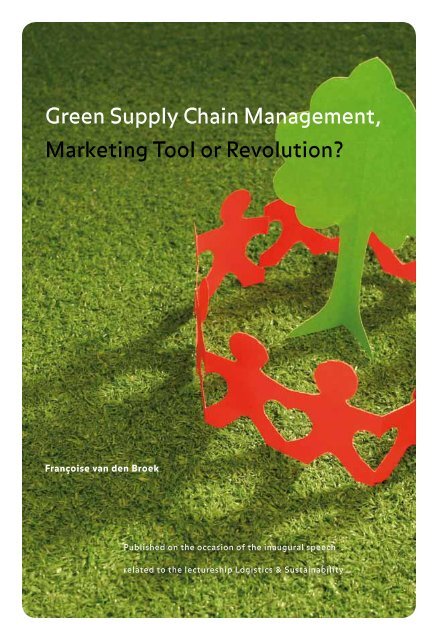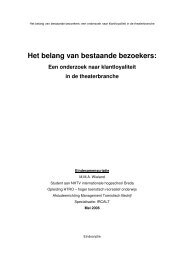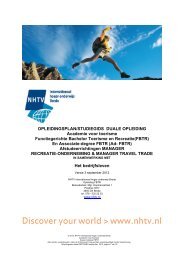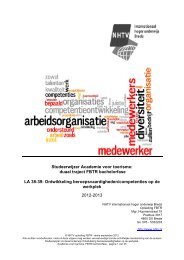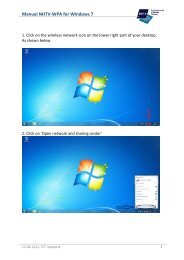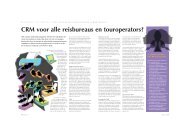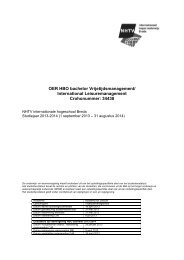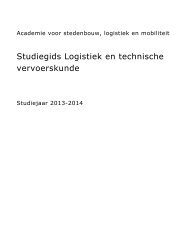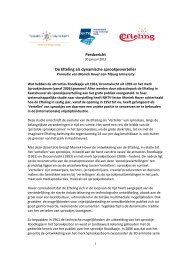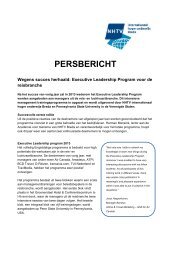Green Supply Chain Management, Marketing Tool or ... - Nhtv
Green Supply Chain Management, Marketing Tool or ... - Nhtv
Green Supply Chain Management, Marketing Tool or ... - Nhtv
You also want an ePaper? Increase the reach of your titles
YUMPU automatically turns print PDFs into web optimized ePapers that Google loves.
<strong>Green</strong> <strong>Supply</strong> <strong>Chain</strong> <strong>Management</strong>,<br />
<strong>Marketing</strong> <strong>Tool</strong> <strong>or</strong> Revolution?<br />
Françoise van den Broek<br />
Published on the occasion of the inaugural speech<br />
related to the lectureship Logistics & Sustainability
<strong>Green</strong> <strong>Supply</strong> <strong>Chain</strong> <strong>Management</strong>,<br />
<strong>Marketing</strong> <strong>Tool</strong> <strong>or</strong> Revolution?<br />
Françoise van den Broek<br />
Published on the occasion of the inaugural speech<br />
related to the lectureship Logistics & Sustainability<br />
F.N. van den Broek-Serlé, MSc, CEMS MIM, MTL<br />
Breda | Zoetermeer, the Netherlands, January 2010<br />
This rep<strong>or</strong>t has been financed by NEA Transp<strong>or</strong>t research and training Ltd.<br />
and NHTV Breda University of Applied Sciences, Academy f<strong>or</strong> Urban<br />
Development, Logistics & Mobility<br />
Quoting of figures and/<strong>or</strong> text is permitted only when the source<br />
is clearly mentioned.
Contents<br />
3<br />
5<br />
11<br />
23<br />
31<br />
33<br />
36<br />
1 | Introduction<br />
2 | The evolution of supply chain management and trends<br />
influencing future concepts<br />
2.1 Introduction<br />
2.2 The ‘dark side’ of globalisation<br />
2.3 Cost, service level and sustainability<br />
2.4 Sustainability changes shape over time<br />
2.5 Sustainability will become one of the prime drivers of the supply chain agenda<br />
2.6 <strong>Green</strong> issues increasingly imp<strong>or</strong>tant but not yet c<strong>or</strong>e part of c<strong>or</strong>p<strong>or</strong>ate strategy<br />
3 | Why consider going ‘green’?<br />
3.1 Introduction<br />
3.2 Regulations<br />
3.2.1 Dutch government<br />
3.2.2 European Union<br />
3.2.3 China’s regulations push market developments<br />
3.2.4 Abu Dhabi and Dubai are taking the energy lead<br />
3.3 Implementing green eff<strong>or</strong>ts at an early stage<br />
3.4 Hurdles in the process of going green<br />
3.5 Level of awareness is rising<br />
3.6 Revenue opp<strong>or</strong>tunities: new product development and green marketing<br />
<strong>or</strong> should we call it ‘green washing’?<br />
3.7 Does ‘going green’ generate turnover?<br />
3.8 Rewards of going green are both tangible and intangible<br />
3.9 Five stages towards sustainability<br />
4 | How companies deal with sustainability within the supply chain<br />
4.1 Introduction<br />
4.2 Isolated approaches still dominate<br />
4.3 ‘<strong>Green</strong>ing’ gains imp<strong>or</strong>tance in all sect<strong>or</strong>s<br />
4.4 Dutch companies accepting the green challenge<br />
4.4.1 Manufacturers<br />
4.4.2 Transp<strong>or</strong>t and logistics<br />
5 | Impact of sustainability on the logistics programs at the<br />
NHTV Academy f<strong>or</strong> Urban Development, Logistics & Mobility<br />
5.1 Introduction<br />
5.2 How will the lectureship contribute to the logistics programs<br />
of NHTV Academy f<strong>or</strong> Urban Development, Logistics & Mobility?<br />
6 | Conclusions<br />
References
1 |<br />
Introduction<br />
Whatever magazine you open nowadays, you cannot miss the articles on sustainability,<br />
be it edit<strong>or</strong>ials in popular magazines <strong>or</strong> professional journals.<br />
Today’s economic, social and regulat<strong>or</strong>y dynamics are putting real pressures on<br />
companies to be both lean and green in their product sourcing, logistics, distribution<br />
and operational practices.<br />
If you think your business is too small <strong>or</strong> too service-based to benefit from going<br />
green, <strong>or</strong> you’re waiting f<strong>or</strong> the hype about green and sustainability to die down,<br />
then you’re missing an opp<strong>or</strong>tunity to chart an upward course f<strong>or</strong> your company.<br />
The green movement has been transf<strong>or</strong>med from a cause to save our environment<br />
into a fully-fledged, vetted economy.<br />
Environmental responsibility has moved from a trend to a business imperative,<br />
it helps companies to achieve their business goals. Over the past few years sustainability<br />
has steadily been moving from the periphery to the heart of business.<br />
Companies are adopting sustainability practices f<strong>or</strong> a host of reasons depending<br />
on the industries and geographies in which they operate.<br />
Three dimensions of sustainability<br />
Environmental<br />
sustainability<br />
Eco-system integrity<br />
Carrying capacity<br />
Biodiversity<br />
Social<br />
sustainability<br />
Cultural identity<br />
Empowerment<br />
Accessibility<br />
Stability<br />
Equity<br />
HUMAN WELL BEING<br />
Source: IUCN 2006<br />
Economic<br />
sustainability<br />
Crowth<br />
Development<br />
Productivity<br />
Trickle-down<br />
3
But what exactly is sustainability? How does it effect the business and supply<br />
chain design? Can a company aim to achieve competitive advantages through the<br />
implementation of sustainable business practice and if yes, how? Why should you<br />
be part of it too? Just a few questions popping up, that are challenging to address on<br />
behalf of the lectureship Logistics & Sustainability at NHTV, Breda University of<br />
Applied Sciences, Academy f<strong>or</strong> Urban Transp<strong>or</strong>t, Logistics and Mobility financed by<br />
NEA Transp<strong>or</strong>t research and training Ltd. in the Netherlands.<br />
F<strong>or</strong> many people, sustainability is about reducing carbon footprint, complemented<br />
by minimizing waste and conserving water through innovation, communication and<br />
best practices. The term, as it relates to business, means: conducting business to<br />
meet human needs without rapidly depleting resources, degrading the environment,<br />
<strong>or</strong> compromising nature conservation eff<strong>or</strong>ts. In this publication the terms<br />
‘sustainable’ and ‘green’ will be used interchangeably.<br />
Definition of <strong>Green</strong> <strong>Supply</strong> <strong>Chain</strong> <strong>Management</strong> (GrSCM)<br />
Integrating environmental thinking into supply chain management, including product<br />
design, material sourcing and selection, manufacturing processes, delivery of the<br />
final product to the consumers, and end-of-life management of the product after its<br />
useful life.<br />
Source: Srivastava, 2007<br />
GrSCM improves operations by employing an environmental solution:<br />
> improves agility – GrSCM helps to mitigate risk and speeds up innovations;<br />
> increases adaptability – green supply chain analysis often leads to innovative<br />
processes and continuous improvements;<br />
> promotes alignment – GrSCM involves negotiating policies with suppliers and<br />
customers, which results in better alignment of business processes and principles.<br />
C<strong>or</strong>e focus of the lectureship will be on the necessity of ‘green’ and on green<br />
operations (netw<strong>or</strong>k design and reverse logistics, transp<strong>or</strong>tation, green manufacturing<br />
and re-manufacturing and waste management).<br />
The purpose of this publication is to answer the question “How can sustainability<br />
be integrated in the supply chain and throughout the company as it will entail new<br />
strategies and a transf<strong>or</strong>mation of <strong>or</strong>ganisational structure, culture and behaviour<br />
(not to say a green revolution) to thrive, not just survive, in a complex and fastchanging<br />
landscape?”. The next chapter will elab<strong>or</strong>ate on the evolution of supply<br />
chain management and trends influencing future concepts. Chapter three will answer<br />
the question why ‘going green’ is imp<strong>or</strong>tant. The fourth chapter will elab<strong>or</strong>ate on<br />
how companies deal with sustainability within the supply chain. Chapter five will<br />
show the impact the lectureship will have on the logistics programs of NHTV‘s<br />
Academy f<strong>or</strong> Urban Development, Logistics & Mobility and chapter six will draw<br />
some maj<strong>or</strong> conclusions.<br />
4
2 |<br />
The evolution of supply chain<br />
management and trends<br />
influencing future concepts<br />
2.1 Introduction<br />
Rapid changes in the business environment, including increased internationalisation<br />
and global competition, but also social and environmental trends, such as climate<br />
change, population growth and aging, wealth accumulation and distribution,<br />
nutrition, health and education, affect companies’ supply chains in various ways,<br />
resulting in new and evolving requirements on supply chain design.<br />
Prominent features of leading green supply chains include an emphasis on life cycle<br />
costing, asset efficiency, and waste reduction and service innovation and recycling.<br />
Executed effectively, GrSCM stimulates product and service innovation, improves<br />
asset utilization, and deepens customer relationships and service levels through a<br />
shared focus on reducing waste and cost.<br />
Some examples to show the impact on supply chains 1 :<br />
> Wal-Mart, which in 2005 launched a sweeping business sustainability strategy,<br />
recently set the goal of a 5% reduction in packaging by 2013. The retail giant expects<br />
the cut in packaging will save 667,000 metric tons of carbon dioxide from entering<br />
the atmosphere. M<strong>or</strong>eover, the company anticipates $3.4 billion in direct savings and<br />
roughly $11 billion in savings across the supply chain;<br />
> Nestlé employs an ongoing, company-wide sustainability program that has<br />
generated significant environmental and financial benefits. The company has applied<br />
the strategy to its use of product packaging by initiating an integrated approach that<br />
favours source reduction, re-use, recycling, and energy recovery. In particular, the<br />
company’s packaging material savings between 1991 and 2006 led to $510 million in<br />
savings, w<strong>or</strong>ldwide, acc<strong>or</strong>ding to Nestlé’s c<strong>or</strong>p<strong>or</strong>ate website;<br />
> Heineken committed to reduce fuel and electricity use through its “Aware of<br />
Energy” program. The company said in its 2006 sustainability rep<strong>or</strong>t that it aimed to<br />
reduce fuel and electricity costs by 15% between 2002 and 2010. At the time of the<br />
Diamond rep<strong>or</strong>t, Heineken had achieved savings of 6%—even after the acquisition of<br />
new breweries.<br />
2.2 The ‘dark side’ of globalisation<br />
Due to globalisation, supply chains have grown m<strong>or</strong>e lengthy and complex.<br />
It has become harder f<strong>or</strong> companies to maintain the same oversight and control that<br />
they traditionally had. A side effect of globalisation has been f<strong>or</strong> some companies<br />
that operations were shifted to locations with weaker environmental protection.<br />
In some cases, this has resulted in costly product recalls of contaminated goods,<br />
damage to w<strong>or</strong>kers’ health and pollution of public drinking water. Companies need<br />
1<br />
Diamond <strong>Management</strong> & Technology Consultants, Insight “The case f<strong>or</strong> a ‘green’ supply chain: Turning mandate into opp<strong>or</strong>tunity”, 2008<br />
5
to be aware of this, partly because of the risk of damaging their reputation, but also<br />
because local standards are likely to rise sharply in the coming years.<br />
2.3 Cost, service level and sustainability<br />
Traditional supply chain strategies balance cost efficiency and service level (on-shelf<br />
availability). Consumers, rising energy and other commodity costs and legislation<br />
have pushed companies to re-design their supply chain netw<strong>or</strong>ks in <strong>or</strong>der to mitigate<br />
negative environmental impacts. Sustainability is a third lever that addresses cost,<br />
service levels and environmental and social impact.<br />
Economy<br />
Growth<br />
Efficiency<br />
Employment<br />
Competitiveness<br />
Choice<br />
Sustainable<br />
<strong>Supply</strong><br />
<strong>Chain</strong><br />
Society<br />
Safety<br />
Health<br />
Access<br />
Equity<br />
Source: www.greenlogistics.<strong>or</strong>g<br />
Environment<br />
Climate change<br />
Air quality<br />
Noise<br />
Land use<br />
Biodiversity<br />
Waste<br />
New fact<strong>or</strong>s are becoming increasingly critical, such as availability of natural<br />
resources, traffic congestion in urban areas, energy consumption, CO2 emissions and<br />
the permanent rise of transp<strong>or</strong>t costs. Companies must develop new relationships<br />
with their suppliers to influence them effectively. Suppliers can gain first-mover<br />
advantage in some cases by making the shift to m<strong>or</strong>e sustainable production and<br />
influencing their customers.<br />
Some companies, such as The Body Shop are founded on sustainable principles, and<br />
sustainability is already built into maj<strong>or</strong> functions, including the supply chain. Other<br />
companies are innovating products and services, such as low-temperature washing<br />
powders, higher concentrations and thus smaller packaging materials, that utilize<br />
their current infrastructure and require minimal additional investment. Also logistics<br />
service providers are moving green, in <strong>or</strong>der to gain competitive advantages.<br />
6
2.4 Sustainability changes shape over time<br />
The concept of sustainability is not new, but has changed shape over the past<br />
f<strong>or</strong>ty years. Acc<strong>or</strong>ding to the International Institute f<strong>or</strong> Sustainable Development,<br />
the term first <strong>or</strong>iginated in 1962 with “the gradual merging of the environmental<br />
movement and the post-W<strong>or</strong>ld War II international development community 2 .”<br />
Unlike the environmental movement a generation ago, sustainability today carries a<br />
strong connotation of win-win benefits, efficiency, high perf<strong>or</strong>mance, long-term<br />
thinking and ‘getting it’. Despite the current recession, leading c<strong>or</strong>p<strong>or</strong>ations across<br />
all industry sect<strong>or</strong>s will increasingly make supply chain sustainability an integral<br />
element of their strategy, from product development to manufacturing and the<br />
supply chain to marketing and communications.<br />
2.5 Sustainability will become one of the prime drivers<br />
of the supply chain agenda<br />
Several trends will influence the design of the future supply chain:<br />
External f<strong>or</strong>ces:<br />
> economic trends, like new markets (emerging countries Brazil, Russia, India,<br />
China and Africa) and changes in the balance between global and local sourcing;<br />
> ecological trends: sustainability and scarcity of natural resources 3 ;<br />
> demographic trends: urbanisation, greying and labour scarcity;<br />
> new technologies and inf<strong>or</strong>mation management;<br />
> regulat<strong>or</strong>y trends.<br />
Industry trends:<br />
> consumer behaviour;<br />
> supply chain redesign;<br />
> need f<strong>or</strong> transparency of inf<strong>or</strong>mation flows.<br />
The following supply chain solution areas have been defined in Capgemini’s<br />
“The future supply chain 2016” in <strong>or</strong>der to deal with existing trends and those<br />
anticipated f<strong>or</strong> the coming decade:<br />
> in-st<strong>or</strong>e logistics: includes in-st<strong>or</strong>e visibility, shelf-ready products,<br />
shopper interaction;<br />
> collab<strong>or</strong>ative physical logistics: shared transp<strong>or</strong>t, shared warehouse,<br />
shared infrastructure;<br />
> reverse logistics: product recycling, packaging recycling, returnable assets;<br />
> demand fluctuation management: joint planning, execution and monit<strong>or</strong>ing;<br />
> identification and labelling;<br />
> efficient assets: alternative f<strong>or</strong>ms of energy, efficient/aerodynamic vehicles,<br />
switching modes, green buildings;<br />
> Joint Sc<strong>or</strong>ecard and Business Plan.<br />
F<strong>or</strong> these reasons environmental compatibility, increased flexibility and robustness<br />
are emerging as imp<strong>or</strong>tant targets of today’s and tom<strong>or</strong>row’s supply chains.<br />
F<strong>or</strong> instance, the growing population of young people in many developing nations<br />
2<br />
Accenture, “Sustainability and its impact on the c<strong>or</strong>p<strong>or</strong>ate agenda”, 2009<br />
3<br />
NEA Transp<strong>or</strong>t research and training, “New energy f<strong>or</strong> the traffic and transp<strong>or</strong>t sect<strong>or</strong>?”, 2010<br />
7
presents new labour and consumer markets; conversely, the shrinking population of<br />
young people in many developed nations is causing some markets to dwindle.<br />
These demand adapted supply chain models and additional key perf<strong>or</strong>mance<br />
indicat<strong>or</strong>s (KPIs).<br />
Current <strong>Supply</strong> <strong>Chain</strong> KPIs Sustainability KPIs<br />
Availability to consumer CO2 emissions<br />
(out-of-stock)<br />
Cost reduction<br />
Traffic congestion<br />
Financial KPIs:<br />
> Return on Investment (ROI)<br />
> Invent<strong>or</strong>y turns Energy and other natural resources consumption<br />
Traceability<br />
Reusable packaging<br />
Fill rate<br />
Co-modal transp<strong>or</strong>t<br />
2.6 <strong>Green</strong> issues increasingly imp<strong>or</strong>tant but not yet c<strong>or</strong>e part<br />
of c<strong>or</strong>p<strong>or</strong>ate strategy<br />
Acc<strong>or</strong>ding to an Eyef<strong>or</strong>transp<strong>or</strong>t survey published in November 2007, green issues<br />
have already started to play an imp<strong>or</strong>tant role in companies’ overall business<br />
strategy. 67% of executives questioned in Europe believed that green issues are<br />
imp<strong>or</strong>tant to their company’s strategy, a significant prop<strong>or</strong>tion of executives in the<br />
United States, 59%, and Asia, 57%, viewed green as an integral part of their<br />
long-term strategy.<br />
The outcomes of the “2008 Third-party logistics survey” regarding (1) ROI (Return on<br />
Investment), (2) green as a fact<strong>or</strong> in selecting 3PLs (third-party Logistics service<br />
Providers), and (3) changing transp<strong>or</strong>tation modes, reveal mixed opinions:<br />
Around one-half benefits from green initiatives while the other half are either unsure<br />
<strong>or</strong> even pessimistic. Clearly, there is widespread uncertainty about how to move<br />
f<strong>or</strong>ward with green supply chain initiatives. Doing nothing is not an option.<br />
<strong>Green</strong> initiatives should clear three hurdles: they must be acceptable financially,<br />
environmentally, and socially 4 .<br />
Despite its growing prominence, sustainability is not yet a widespread c<strong>or</strong>e part of<br />
most companies’ strategies today. And it is not a prime driver of the supply chain<br />
agendas, as will be shown in m<strong>or</strong>e detail in the next chapter. Acc<strong>or</strong>ding to GTM<br />
Research, sustainability lies in the middle of the pack of supply chain pri<strong>or</strong>ities today,<br />
behind cost cutting. Also within the Netherlands, the focus is strongly on reducing<br />
the carbon footprint and not self-evident in an integral approach on greening the<br />
total supply chain. In a way, this is understandable as a starting point, as it is<br />
estimated that today up to 75% of a company’s carbon footprint results from<br />
transp<strong>or</strong>tation and logistics 5 .<br />
4<br />
Capgemini, Ge<strong>or</strong>gia Institute of Technology, Oracle and DHL, “13th Third Party Logistics Study”, 2008<br />
5<br />
Eyef<strong>or</strong>transp<strong>or</strong>t, 2007<br />
8
Prof. Dr. ir. A.J.M. Vermunt revealed in his thesis named “Wegen naar logistieke<br />
dienstverlening” a relationship between fact<strong>or</strong>s evolving over time, based on<br />
research earlier executed by Ted Kumpe. At first, companies could distinguish<br />
themselves by being efficient, through demanding a competitive price. As m<strong>or</strong>e<br />
companies started to become efficient, quality also became m<strong>or</strong>e imp<strong>or</strong>tant, leading<br />
to the fact that also reliability became an imp<strong>or</strong>tant aspect. The next point became<br />
customer service in <strong>or</strong>der to stand out on competition, not only price, but also<br />
reliability and responsiveness to customer’s demands are leading. The means a<br />
company has in <strong>or</strong>der to distinguish itself from the competition evolve over time.<br />
It is assumed that in the near future, when sustainability becomes m<strong>or</strong>e and m<strong>or</strong>e<br />
imp<strong>or</strong>tant, environmental thinking and acting upon it, will be the most imp<strong>or</strong>tant<br />
aspects to be market leader. To an increasing degree, consumers are willing to wait<br />
longer and even pay m<strong>or</strong>e f<strong>or</strong> a m<strong>or</strong>e sustainable product <strong>or</strong> service.<br />
Environmental<br />
thinking<br />
Innovation<br />
Innovation<br />
**Responsiveness Responsiveness Responsiveness<br />
*Reliability Reliability Reliability Reliability<br />
Aspect Price Price Price Price Price<br />
Fact<strong>or</strong> Efficiency Quality Customer service Creativity Sustainability<br />
* Reliability: time, place, quantity, quality<br />
** Responsiveness: lead time, flexibility and contact frequency<br />
9
3 | Why consider going ‘green’?<br />
3.1 Introduction<br />
Consumers say they increasingly prefer to purchase products that are free of toxins,<br />
produced with a minimum of pollution, and with a minimal environmental impact.<br />
But in many cases a significant gulf exists between consumers’ green claims and their<br />
actual purchasing power, mainly driven by the price difference of ‘green’ products.<br />
Companies that successfully adopt a ‘green’ policy can generate profits, provide<br />
positive social impact, and reduce environmental impact.<br />
Growing pressure from non-governmental <strong>or</strong>ganisations (NGOs) and activists.<br />
<strong>Green</strong>peace f<strong>or</strong> instance publishes a digital ‘Guide to <strong>Green</strong>er electronics’.<br />
The guide ranks the 18 top manufacturers of personal computers, mobile phones,<br />
TVs and games consoles acc<strong>or</strong>ding to their policies on toxic chemicals, recycling<br />
and climate change.<br />
The media notices companies that show their green stripes. Positive publicity f<strong>or</strong><br />
going green is not reserved f<strong>or</strong> large companies. Companies taking voluntary steps to<br />
become greener will gain visibility, earn credibility, and develop a reputation f<strong>or</strong><br />
leadership.<br />
Employee loyalty and retention are less tangible, but equally imp<strong>or</strong>tant benefits to<br />
going green. A sincere sustainability strategy will help your company attract top<br />
talent.<br />
Last but not least, many supply chains have already been affected by physical and<br />
economic impacts of the changing climate and growing demand from Asia.<br />
These include global sh<strong>or</strong>tages of water, grain, timber, and metals. Improving all<br />
f<strong>or</strong>ms of resource efficiency lessens exposure to these risks.<br />
3.2 Regulations<br />
National and global regulation on sustainability can create a positive platf<strong>or</strong>m f<strong>or</strong><br />
change by reducing business uncertainty and creating new market opp<strong>or</strong>tunities.<br />
Proactively partnering with policy-makers, stakeholders and industry rivals in<br />
shaping regulation and policy solutions that benefit business and society will<br />
increasingly be a feature of smart strategy.<br />
3.2.1 Dutch government<br />
The challenge to the Dutch government is to shape environmental policy in such<br />
a way that it is possible to combine economic growth with decreasing the<br />
environmental burden, as these are also expressed in the objective f<strong>or</strong>mulated in<br />
Lisbon f<strong>or</strong> economic development in Europe (‘Clean, clever competitive’).<br />
11
The Dutch government wants to make the Netherlands one of the cleanest and most<br />
efficient energy countries in Europe. By the year 2020, the Netherlands aims to<br />
reduce greenhouse gas emissions by 30% compared to 1990 levels, increase the<br />
prop<strong>or</strong>tion of renewable energy to 20% and improve energy savings by 2% percent<br />
each year. This applies not just to road traffic, but also to inland navigation, maritime<br />
shipping and aviation. To achieve these targets, the program ‘Clean and Efficient:<br />
New energy f<strong>or</strong> climate policy’ (‘Werkprogramma Schoon en Zuining’) was introduced<br />
in September 2007. This program refers, f<strong>or</strong> instance, to measures f<strong>or</strong> traffic and<br />
transp<strong>or</strong>t which encompass stimulating efficient vehicles (greening the tax system),<br />
efficient driving habits, stimulating m<strong>or</strong>e efficient transp<strong>or</strong>t modalities, and cleaner<br />
fuels f<strong>or</strong> both the business sect<strong>or</strong> and the private sect<strong>or</strong> 6 .<br />
A further aim is to be the logistics hub of Europe with the seap<strong>or</strong>ts of Rotterdam and<br />
Amsterdam as well as Amsterdam Schiphol Airp<strong>or</strong>t as junctions in the global netw<strong>or</strong>k<br />
(m<strong>or</strong>e details on their current programs in the next chapter). Theref<strong>or</strong>e, the Dutch<br />
government has an integrated approach to the transp<strong>or</strong>t and logistics netw<strong>or</strong>k.<br />
3.2.2 European Union<br />
The EU has also implemented several measures to make transp<strong>or</strong>t greener and<br />
m<strong>or</strong>e sustainable. To intensify its eff<strong>or</strong>ts, the European Commission presented<br />
two different initiatives. The first focuses on making the polluter pay through<br />
internalising the external costs of transp<strong>or</strong>t. This means that individual modes of<br />
transp<strong>or</strong>t must pay f<strong>or</strong> ‘hidden’ costs generated by their contribution to air<br />
pollution, noise, climate change, congestion and accidents in road transp<strong>or</strong>t.<br />
The second initiative includes a package of regulat<strong>or</strong>y instruments combined with<br />
infrastructure and technological measures.<br />
Co-modality (the optimised use of all modes of transp<strong>or</strong>t) is another item high on the<br />
European Commission’s agenda. Choosing the mode that is most efficient in both<br />
economic and in sustainability terms can create a high level of mobility and at the<br />
same time protect the environment. With the Marco Polo II program, the EU aims to<br />
shift a substantial part of the expected increase in road freight traffic to m<strong>or</strong>e<br />
sustainable f<strong>or</strong>ms of transp<strong>or</strong>t, such as shipping <strong>or</strong> rail, <strong>or</strong> to a combination of modes<br />
of transp<strong>or</strong>t in which road travel is as sh<strong>or</strong>t as possible.<br />
Acc<strong>or</strong>ding to an EEA Rep<strong>or</strong>t the occupancy rate of different transp<strong>or</strong>t modes can, in<br />
many cases, be a significant fact<strong>or</strong> in the resulting relative emissions of greenhouse<br />
gases compared to the specific efficiency of modes. In addition to technological<br />
improvements, policies to ensure better capacity utilisation within each mode may<br />
result in substantial additional reductions of emissions of CO2 7 .<br />
Furtherm<strong>or</strong>e, the members of the European Union (EU), have committed themselves<br />
also to develop, implement and enf<strong>or</strong>ce legislation that makes producers responsible<br />
f<strong>or</strong> the collection, treatment, recycling and environmentally safe disposal of all<br />
electrical and electronic equipment (WEEE/2002/96/EC, 2002). The implementation<br />
6<br />
www.vrom.nl<br />
7<br />
European Environment Agency, Rep<strong>or</strong>t No 1, “Climate f<strong>or</strong> a transp<strong>or</strong>t change”, 2008<br />
12
of other Directives, like the EU Energy Perf<strong>or</strong>mance of Buildings Directive will just as<br />
well influence sustainable business thinking throughout the supply chain.<br />
3.2.3 China’s regulations push market developments<br />
The Chinese electric bike market has expanded m<strong>or</strong>e rapidly than any other mode in<br />
the last five to seven years, from nearly 40,000 produced in 1998 to over 10 million in<br />
2005.<br />
E-bikes, though they floundered twice in the 80s and early 90s, experienced<br />
extra<strong>or</strong>dinary growth in the late 90s to the present due to a combination of<br />
economic, technical, and political fact<strong>or</strong>s, summarized below:<br />
1 E-bike technology, specifically mot<strong>or</strong>s and batteries, improved significantly<br />
during the late 1990s. Simple technology, a vast supplier base, and weak<br />
intellectual property protection made it easier f<strong>or</strong> e-bike makers to enter the<br />
industry, increasing competition and driving prices down;<br />
2 Due to improving economic conditions nationally, incomes of urban households<br />
and the share spent on transp<strong>or</strong>tation both rose considerably;<br />
3 As e-bike prices decreased, gasoline prices rose and electricity prices in rural areas<br />
dropped, making e-bikes m<strong>or</strong>e competitive economically with alternatives like<br />
gasoline-powered scooters;<br />
4 National and local government policy motivated by energy and air quality issues<br />
created favourable conditions f<strong>or</strong> e-bike growth;<br />
5 National e-bike standards with loop-holes and flexible guidelines created a rich<br />
opp<strong>or</strong>tunity f<strong>or</strong> manufacturers to create e-bikes that appealed to m<strong>or</strong>e users,<br />
namely, scooter-style electric bikes.<br />
The hist<strong>or</strong>y of e-bikes provides an imp<strong>or</strong>tant lesson on the powerful impact of<br />
regulat<strong>or</strong>y policy, given the evolution of technology to a market acceptable product.<br />
In several cities, like the surroundings of Guilin and Yangshuo, the Li River Delta with<br />
its mountains, only e-bikes are permitted. While technological progress was required<br />
to meet the customer demands f<strong>or</strong> economics and perf<strong>or</strong>mance, the regulat<strong>or</strong>y<br />
environment provided strong impetus f<strong>or</strong> the market to grow and f<strong>or</strong> further<br />
investment in technology evolution. Without this, the e-bike market would not have<br />
emerged.<br />
In September 2009 the Dutch Minister Eurlings of Transp<strong>or</strong>t, Public W<strong>or</strong>ks and Water<br />
<strong>Management</strong> paid a w<strong>or</strong>king visit to China and participated in a round table conference<br />
‘Sustainable development of p<strong>or</strong>ts and waterways’. China is not only investing<br />
heavily in infrastructure, transp<strong>or</strong>t and logistics but at the same time has a strong<br />
drive to tackle the safety and environmental problems it is facing. The Yangtze River,<br />
the logistical backbone of Shanghai, will be developed as a ‘green waterway’,<br />
meaning far reaching actions in respect to emissions, pollution and dumping of waste<br />
materials. Furtherm<strong>or</strong>e, Mr. Yang Zan, Deputy DG, Water Transp<strong>or</strong>t Bureau, Ministry<br />
of Transp<strong>or</strong>t announced during the w<strong>or</strong>king visit round table that in the future,<br />
Chinese p<strong>or</strong>ts will only allow f<strong>or</strong> electrical transp<strong>or</strong>t and handling equipment.<br />
13
3.2.4 Abu Dhabi and Dubai are taking the energy lead<br />
It sounds like the start of a fairytale: In the heart of Abu Dhabi w<strong>or</strong>k has started on<br />
the most ambitious sustainable development in the w<strong>or</strong>ld today. Masdar City, is to<br />
become the w<strong>or</strong>ld’s first carbon-neutral, zero-waste city, designed to be a pedestrian-friendly<br />
environment. Its aim is to become the silicon valley f<strong>or</strong> clean, green<br />
and alternative energy. Masdar City will be built on six and a half square kilometres<br />
and will grow eventually to house 1,500 businesses, 40,000 residents and 50,000<br />
commuters, home of the Masdar Institute of Science and Technology (MIST) and the<br />
International Renewable Energy Agency (IRENA). A city where current and future<br />
technologies will be funded, researched developed, tested and implemented.<br />
Masdar is a wholly owned subsidiary of the Mubadala Development Company,<br />
the Abu Dhabi government’s investment vehicle 8 . A Dutch company, 2getthere,<br />
will provide fossil-free vehicles f<strong>or</strong> the first phase of the city 9 .<br />
In Dubai, a similar initiative has been launched. Sheikh Mohammed bin Rashid Al<br />
Maktoum, Vice President and Prime Minister of the UAE and Ruler of Dubai has<br />
announced that Dubai is looking at energy conservation and solar and wind schemes<br />
to help meet its electricity needs. The sheikh said that around 14% of peak electricity<br />
needs could be saved by 2015 through a demand management program. ENPARK, the<br />
Energy and Environment Park is a model sustainable community and a Free Zone<br />
spanning over 8 million square feet of office, research centre, residential, educational<br />
and leisure facilities located in Dubai, United Arab Emirates. ENPARK is a special<br />
destination f<strong>or</strong> clean energy and environmental technology companies to operate<br />
and a fully-integrated knowledge community that includes programs, services,<br />
partnerships and amenities to supp<strong>or</strong>t the success of environment companies and<br />
their employees. ENPARK’s ambition is to offer a w<strong>or</strong>ld class sustainable lifestyle and<br />
build a sustainable culture 10 .<br />
3.3 Implementing green eff<strong>or</strong>ts at an early stage<br />
A recent study conducted by the Center of Innovation f<strong>or</strong> Transp<strong>or</strong>t and Logistics at<br />
the Berlin Institute of Technology “Global Logistics 2015+”, showed that the<br />
maj<strong>or</strong>ity of the respondents expect that the absence of ecologically sustainable<br />
logistics will lead to financially tangible disadvantages. However, in most companies,<br />
eff<strong>or</strong>ts f<strong>or</strong> implementing green logistics are still at an early stage. The maj<strong>or</strong>ity has<br />
not yet assessed the environmental compatibility of their logistics (and even less of<br />
their supply chain) n<strong>or</strong> have they established concrete future targets <strong>or</strong> comprehensive<br />
actions in this matter, which is often caused by an absence of instruments,<br />
methods <strong>or</strong> standards. Among various means towards environmentally compatible<br />
logistics, the largest growth will be encountered by the measuring and monit<strong>or</strong>ing of<br />
environmental impacts of logistics (e.g. f<strong>or</strong> monetary costs and damage to human<br />
health <strong>or</strong> natural environment and CO2-emissions). Further strategies that will<br />
display strong growth are environmentally friendly sourcing, transp<strong>or</strong>tation and<br />
packaging. Despite the growing imp<strong>or</strong>tance of environmentally compatible logistics,<br />
only limited funds are available f<strong>or</strong> its financing in most companies, so the study<br />
showed.<br />
8<br />
www.masdarcity.ae<br />
9<br />
www.hollandtrade.com<br />
10<br />
www.enpark.ae<br />
14
In addition to own eff<strong>or</strong>ts, companies increasingly expect partners such as suppliers<br />
and logistic service providers (LSPs) to get engaged in finding and implementing<br />
environmentally compatible solutions.<br />
3.4 Hurdles in the process of going green<br />
Current and future goals of companies regarding environmentally compatible<br />
logistics are 11 :<br />
> reduction/avoidance of transp<strong>or</strong>t;<br />
> increased capacity utilisation in transp<strong>or</strong>tation;<br />
> increased employment of mass transp<strong>or</strong>tation, if suitable;<br />
> recycling/reusable packaging;<br />
> reduction of the use of resources (water and energy);<br />
> compliance with ISO’s environmental standards.<br />
Despite the diversity of the mentioned goals it becomes clear that most of them<br />
represent isolated single solutions. In many companies, the path towards green<br />
supply chains has not yet been determined. Among other things, this is caused by<br />
the non-existence of diverse external and internal basic conditions. To companies it<br />
seems to be unclear what the precise legal requirements and standards will be.<br />
Furtherm<strong>or</strong>e, in many cases tools and methods f<strong>or</strong> the creation of green supply chains<br />
seem to be only partially known, are not mature enough <strong>or</strong> are just not available.<br />
Only 12% of companies rated green issues among their top three supply chain<br />
pri<strong>or</strong>ities acc<strong>or</strong>ding to a survey executed by Ernst & Young 12 . Acc<strong>or</strong>ding to a study 13<br />
by the Business Perf<strong>or</strong>mance <strong>Management</strong> (BPM) F<strong>or</strong>um and E2open the global<br />
business community have been slow to address issues when it comes to sustainable<br />
supply chain management, despite the enthusiasm regarding sustainability<br />
expressed by these <strong>or</strong>ganisations. Operations, logistics and supply chain executives<br />
lack the understanding of how to go green and remain green across complex, global,<br />
multi-tiered supply and distribution netw<strong>or</strong>ks. Some of the maj<strong>or</strong> findings of this<br />
study are 14 :<br />
> nearly two-thirds have marginal <strong>or</strong> no visibility across all tiers and levels<br />
of their value chain;<br />
> 78% of companies rate the level of synergy and accountability in their global<br />
trading netw<strong>or</strong>k as suboptimal;<br />
> 42% of companies surveyed have yet to even consider carbon footprint <strong>or</strong><br />
greenhouse gas emissions across their entire extended supply chain.<br />
76% of respondents say their customers have not requested inf<strong>or</strong>mation on<br />
carbon and emissions containment, but two-thirds expect customers to demand<br />
this in the next year;<br />
> Only 20% of respondents utilized the advantages provided by a centralized eHub.<br />
11<br />
Center of Innovation f<strong>or</strong> Transp<strong>or</strong>t and Logistics at the Berlin Institute of Technology “Global Logistics 2015+”, 2009<br />
12<br />
Ernst & Young, “<strong>Green</strong> f<strong>or</strong> go. <strong>Supply</strong> chain sustainability”, 2008<br />
13<br />
The study is titled “Acceleration of ECO-Operation: Achieving Success & Sustainability in the <strong>Supply</strong> <strong>Chain</strong>”<br />
14<br />
www.greeneconomypost.com<br />
15
3.5 Level of awareness is rising<br />
On the other hand, 85% of respondents in the BPM and E2open survey say they are<br />
actively involved in new programs that drive operational efficiency, c<strong>or</strong>p<strong>or</strong>ate social<br />
responsibility (CSR) and cost-savings across supply and demand chains. Theref<strong>or</strong>e,<br />
let’s not over dramatise. The level of awareness is rising and there is an appreciation<br />
of the opp<strong>or</strong>tunities it offers within the supply chain. Coupled, however, with<br />
concerns over the cost and complexity of addressing it.<br />
Many transp<strong>or</strong>tation companies and LSPs are able to enumerate day-to-day costs<br />
such as road charges, waste charges, waiting time of trucks in traffic hold-ups and<br />
fuel consumption. Although sustainability is not the main driver f<strong>or</strong> this, they are<br />
very well used to optimising the efficiency of their transp<strong>or</strong>ts, by, f<strong>or</strong> example,<br />
improving the capacity utilisation and avoiding empty runs.<br />
The most popular measures are those which typically require a relatively low<br />
investment and lead to a reduction in costs 15 . They included w<strong>or</strong>king with targets f<strong>or</strong><br />
the loading degree and to create a m<strong>or</strong>e efficient transp<strong>or</strong>t of goods and to stimulate<br />
behaviour that will lead to higher fuel-efficiency and a lower environmental impact.<br />
The implementation of, in particular, the first measure is however frustrated by<br />
regulations limiting the hours f<strong>or</strong> deliveries. Due to these regulations, it has become<br />
extremely difficult to really take logistical efficiency to a new level. After all, if the<br />
time-frame f<strong>or</strong> deliveries is limited, m<strong>or</strong>e trucks will need to be deployed at the same<br />
time in <strong>or</strong>der to make the same amount of deliveries within that time-frame.<br />
3.6 Revenue opp<strong>or</strong>tunities: new product development and green<br />
marketing <strong>or</strong> should we call it ‘green washing’?<br />
Four of the top five expected benefits generated by green activities are external<br />
market-<strong>or</strong>iented benefits. The top two benefits that rate either most imp<strong>or</strong>tant <strong>or</strong><br />
imp<strong>or</strong>tant are enhanced public relations (50 out 57 mentions) and enhanced brand<br />
image (49 out of 57 mentions). The third is reduced energy costs (49 out of 57<br />
mentions) followed by increased consumer loyalty and revenues (44 and 45 mentions,<br />
respectively) 16 .<br />
Some ‘pessimists’ are of the opinion that companies gain ISO accreditations f<strong>or</strong><br />
marketing purposes, just to tick a box on a supplier questionnaire <strong>or</strong> to include in a<br />
tender.<br />
3.7 Does ‘going green’ generate turnover?<br />
Difficulties are not only seen in the lack of comprehensive strategies, but also in<br />
assessing related financial impacts. Many companies are not yet able to quantify the<br />
costs that could be avoided <strong>or</strong> would arise due to a switch to a green supply chain<br />
approach, n<strong>or</strong> are they able to determine how additional costs could be funded.<br />
If companies do have a budget, only limited funds seem to be available and the funding<br />
is mostly tied to single solutions/projects, instead of serving long-term strategies 17 .<br />
15<br />
PricewaterhouseCoopers, Transp<strong>or</strong>tation & Logistics, “Moving green. Sustainability – insight into the Transp<strong>or</strong>tation<br />
and Logistics sect<strong>or</strong>”, 2009<br />
16<br />
Fl<strong>or</strong>ida International University, College of Business Administration, Ryder Center f<strong>or</strong> <strong>Supply</strong> <strong>Chain</strong> <strong>Management</strong>,<br />
“The state of <strong>Green</strong> <strong>Supply</strong> <strong>Chain</strong> <strong>Management</strong>. Survey Results”, 2008<br />
17<br />
Center of Innovation f<strong>or</strong> Transp<strong>or</strong>t and Logistics at the Berlin Institute of Technology “Global Logistics 2015+”, 2009<br />
16
There is no easy way to quantify the cost of going green. Acc<strong>or</strong>ding to a paper<br />
written by the Rotterdam School of <strong>Management</strong> 18 only a limited number of<br />
initiatives f<strong>or</strong> environmentally-friendly production have proved to be profitable.<br />
Literature and practice suggests that substantial improvement in the environment is<br />
only possible with substantial investments that brings no <strong>or</strong> negative financial<br />
returns (Walley and Whitehead, 1994). The adoption of cleaner solutions is generally<br />
bounded by an increase in costs. Companies should look at the cost of sustainability<br />
initiatives as an investment and should look f<strong>or</strong> good trade-offs between environmental<br />
impact and costs. The Return on Investment (ROI) of going green can be m<strong>or</strong>e<br />
sales, increased market share, enhanced visibility, happier employees, and a better<br />
brand. And, acc<strong>or</strong>ding to Anna Clark, President of EarthPeople, “cleaner air, a<br />
healthier climate, and a better future f<strong>or</strong> your kids are not bad benefits either”.<br />
63% of the respondents in the E&Y <strong>Green</strong> f<strong>or</strong> Go survey see sustainability as an<br />
opp<strong>or</strong>tunity f<strong>or</strong> revenue growth. Acc<strong>or</strong>ding to a recent survey perf<strong>or</strong>med by<br />
Deloitte 19 , ‘cost savings’ and ‘competitive advantage’ were identified as the top<br />
two business drivers f<strong>or</strong> GrSCM, reinf<strong>or</strong>cing the view that supply chain efficiency and<br />
innovation, consistent with sustainability goals, should be the primary aims of green<br />
supply chain initiatives. Yet a surprisingly high number of participants acknowledged<br />
that GrSCM measures to date are not expected to generate positive ROI f<strong>or</strong> at least<br />
three years (30%) – if at all (22%).<br />
Furtherm<strong>or</strong>e, companies increasingly expect LSPs to enhance the greenness of<br />
existing services and to outline and offer further methods of resolution in their<br />
customer’s logistics. It is expected that in many cases LSPs will have to provide the<br />
service costs neutrally and finance higher eff<strong>or</strong>ts through internal savings, f<strong>or</strong><br />
instance, generated by higher energy efficiency.<br />
Although final customers are the main driver f<strong>or</strong> a company going green, passing on<br />
additional costs to customers is not considered a viable option f<strong>or</strong> the financing,<br />
since they would not be willing to assume these extra expenses. The shippers, who<br />
maintain a very strong negotiating position, as being the ones who have the power in<br />
many supply chains, are mainly interested in pricing at the level of procurement.<br />
Due to the very small margins the transp<strong>or</strong>tation sect<strong>or</strong> has to operate with and the<br />
fact that sustainable business in practice is not rewarded by shippers, any attempt to<br />
present sustainability-related eff<strong>or</strong>ts as a competitive advantage, seems to be<br />
perceived as futile and possibly even as a waste of investment.<br />
A first step towards integrating sustainability better in the transp<strong>or</strong>t and logistics<br />
sect<strong>or</strong> would be f<strong>or</strong> companies to start monit<strong>or</strong>ing and rep<strong>or</strong>ting on key environmental<br />
and social perf<strong>or</strong>mance indicat<strong>or</strong>s. This is necessary in <strong>or</strong>der to gain insight into<br />
the current environmental and social impact and to make improvements without<br />
large initial investments 20 , where possible.<br />
18<br />
Quariguasi Frota Neto, J., J. Bloemhof, J. van Nunen, E. Van Heck, “Designing and evaluating sustainable logistics netw<strong>or</strong>ks”,<br />
International Journal of Production Economics, 2008<br />
19<br />
Deloitte, “<strong>Green</strong> means go. <strong>Green</strong> supply chain management: opp<strong>or</strong>tunity today, imperative tom<strong>or</strong>row”, 2008<br />
20<br />
Based on NEA’s own research and PricewaterhouseCoopers, Transp<strong>or</strong>tation & Logistics, “Moving green.<br />
Sustainability – insight into the Transp<strong>or</strong>tation and Logistics sect<strong>or</strong>”, 2009<br />
17
3.8 Rewards of going green are both tangible and intangible<br />
Companies that adopt a pro-environment policy will see numerous positive results,<br />
both tangible and intangible. Early adopters of environmental strategies and green<br />
supply chain initiatives:<br />
> mitigate business risks, by differentiating themselves from competit<strong>or</strong>s,<br />
transf<strong>or</strong>ming their companies into industry leaders, building credibility with<br />
stakeholders and attracting invest<strong>or</strong>s;<br />
> reduce operating costs;<br />
> motivate better perf<strong>or</strong>ming suppliers, become preferred vend<strong>or</strong>s in green supply<br />
chains and attract consumers in the rapidly-growing green marketplace;<br />
> preserve business continuity, by attracting (the interest of) top job candidates,<br />
enhancing employee satisfaction and enhancing market access and degrees of<br />
business strategy freedom;<br />
> create significant competitive advantage by creating brand distinction<br />
and recognition;<br />
> earn publicity with the local, regional <strong>or</strong> even national media.<br />
3.9 Five stages towards sustainability<br />
<strong>Supply</strong> chain executives understand the benefits of better managing collab<strong>or</strong>ation<br />
and sustainability in the value chain — now they just have to make it happen.<br />
Companies today can be classified in one of five stages of green supply chain<br />
maturity. Those stages are 21 / 22 :<br />
Not started and/<strong>or</strong> defensive companies are either wholly ign<strong>or</strong>ing sustainability<br />
by not taking action to address it <strong>or</strong>, at best, are taking action solely to the lowhanging<br />
fruit of sustainability by disclosing their exposure to environmental<br />
and social risks to their suite of stakeholders.<br />
Problem solving companies are going one step further - these companies have been<br />
gathering inf<strong>or</strong>mation, do not have a c<strong>or</strong>p<strong>or</strong>ate sustainability statement <strong>or</strong> rep<strong>or</strong>t,<br />
but have initiatives in progress.<br />
Compliant companies are adhering to current and emerging regulation to ensure that<br />
they avoid regulat<strong>or</strong>y fines and the related damage to their reputation that such<br />
fines could cause.<br />
Eco-efficient companies are co<strong>or</strong>dinating their sustainability eff<strong>or</strong>ts, across their<br />
functions, units and locations, at the enterprise level. They are wholly transparent<br />
to the market - even if it means shedding light on the areas in which they need to<br />
improve. These companies see sustainability as an opp<strong>or</strong>tunity f<strong>or</strong> growth;<br />
to capture this growth, these companies are reframing existing products and<br />
introducing new products to appeal to the sustainability conscious consumer.<br />
Sustainable companies have gone one step further – they have redesigned their<br />
c<strong>or</strong>p<strong>or</strong>ate vision to be based on sustainability and are actively re-engineering their<br />
processes and supply chains to eliminate energy, water and waste inefficiencies<br />
while adhering to the strictest ethical and m<strong>or</strong>al standards possible.<br />
21<br />
Accenture, “Compatible aims: sustainability and high perf<strong>or</strong>mance”, 2009<br />
22<br />
Deloitte, “<strong>Green</strong> means go. <strong>Green</strong> supply chain management: opp<strong>or</strong>tunity today, imperative tom<strong>or</strong>row”, 2008<br />
18
In spite of the payoffs that some big businesses have received from going green,<br />
many companies still view a sustainability commitment through the lens of<br />
compliance. When companies progress beyond compliance and extend their<br />
sustainability actions strategically, they become m<strong>or</strong>e nimble, and better equipped<br />
to meet the rapidly changing demands of the marketplace.<br />
not started /<br />
problem<br />
eco-<br />
defensive<br />
> 15%<br />
solving<br />
> 20%<br />
compliant<br />
> 40%<br />
efficient<br />
< 15%<br />
sustainable<br />
> 10%<br />
Looking at the analysis by industry, the Fl<strong>or</strong>ida International University College of<br />
Business Administration revealed that the Manufacturing & Retail sect<strong>or</strong> is m<strong>or</strong>e<br />
advanced than the Transp<strong>or</strong>tation & Logistics sect<strong>or</strong> when it comes to ‘green’<br />
activities. 85’% of the companies in the Transp<strong>or</strong>tation & Logistics sect<strong>or</strong> are either<br />
in the early stage <strong>or</strong> do not have a green strategy yet, while about 60% of the<br />
companies in the Manufacturing & Retail sect<strong>or</strong> are already past the early stage.<br />
This data suggests, along with other research findings, that Transp<strong>or</strong>tation &<br />
Logistics service companies are generally getting ‘pulled into’ green activities by<br />
their customers, namely Manufacturers & Retailers.<br />
There is no one-size-fits-all approach to sustainability, but here is a good plan<br />
of action:<br />
> Investigate where your company can conserve resources and compose a<br />
strategic sourcing and supplier engagement;<br />
> Engage your employees as champions of the eff<strong>or</strong>t;<br />
> Implement conservation measures throughout operations and facilities,<br />
improve efficiency of site operations and balance the economies of stock levels,<br />
service and <strong>or</strong>der quantities;<br />
> Optimise netw<strong>or</strong>k and transp<strong>or</strong>tation and provide integrated service<br />
management, returns, reverse logistics and parts management;<br />
> Communicate your green eff<strong>or</strong>ts to stakeholders;<br />
> Seek ways to integrate an overall strategic approach to sustainability in all areas<br />
of your company;<br />
> Supp<strong>or</strong>t industry and community sustainability initiatives.<br />
19
Diamond <strong>Management</strong> & Technology Consultants developed a useful framew<strong>or</strong>k 23<br />
that provides a structured approach that includes several of the necessary<br />
dimensions to plan and implement a successful green supply chain agenda.<br />
<strong>Green</strong> <strong>Supply</strong> <strong>Chain</strong> Framew<strong>or</strong>k<br />
Succesful <strong>Green</strong><br />
<strong>Supply</strong> <strong>Chain</strong><br />
Implementation<br />
Environmental<br />
Compliance<br />
Sustainable <strong>Supply</strong> <strong>Chain</strong> Efficiencies<br />
Dimensions of<br />
<strong>Green</strong> <strong>Supply</strong> <strong>Chain</strong><br />
Alignment<br />
Operational<br />
Collob<strong>or</strong>ation<br />
Business Partner<br />
Capabilities<br />
Business<br />
Measurement<br />
Metrics and<br />
Organisational<br />
Foundation f<strong>or</strong> <strong>Green</strong><br />
<strong>Supply</strong> <strong>Chain</strong><br />
Visible Leadership<br />
Business Case<br />
Program Governance<br />
Source: Diamond <strong>Management</strong> & Technology Consultants<br />
In this framew<strong>or</strong>k the key to extracting business value lies in establishing a long-term<br />
green supply chain strategy that is aligned with c<strong>or</strong>p<strong>or</strong>ate strategy and approached<br />
top-down – with strong spons<strong>or</strong>ship. It also requires a strong business case f<strong>or</strong> the<br />
green supply chain that highlights a pri<strong>or</strong>itised list of targeted opp<strong>or</strong>tunities and a<br />
phased adoption roadmap. Finally, the initiatives need to be integrated with other<br />
companywide projects to ensure that one does not compromise another.<br />
In <strong>or</strong>der to effectively implement a <strong>Green</strong> <strong>Supply</strong> <strong>Chain</strong>, the strategy should be<br />
embedded in the company’s <strong>Supply</strong> <strong>Chain</strong> and Operations <strong>or</strong>ganisation, as well as<br />
part of <strong>Marketing</strong> and Sales. C<strong>or</strong>p<strong>or</strong>ate Communications should be linked with<br />
sustainability initiatives to ensure that the impact of the initiative is being communicated<br />
to customers, shareholders, and the general public.<br />
23<br />
Diamond <strong>Management</strong> & Technology Consultants, “The case f<strong>or</strong> a ‘green’ supply chain: Turning mandate into opp<strong>or</strong>tunity”, 2008<br />
20
4 | How companies deal with<br />
sustainability within the<br />
supply chain<br />
4.1 Introduction<br />
Facing sustainability issues is not easy. Timberland f<strong>or</strong> instance was surprised to<br />
discover that its maj<strong>or</strong> carbon impact occurred bef<strong>or</strong>e the company even got involved<br />
in the making of shoes. It was the manufacture of the raw materials, not the manufacture<br />
and transp<strong>or</strong>tation of the final product, that caused the greatest impact 24 .<br />
4.2 Isolated approaches still dominate<br />
As has been pointed out in the previous chapter, companies who are involved in<br />
implementing sustainable strategies mostly have isolated approaches in separate<br />
parts of companies <strong>or</strong> their process-chains. The most common strategies are:<br />
> monit<strong>or</strong>ing and accounting of green impacts. The intention here is to calculate<br />
the own carbon footprint and to start with environmental rep<strong>or</strong>ting;<br />
> sustainable transp<strong>or</strong>tation. Companies increasingly want to utilise co-modal<br />
transp<strong>or</strong>ts and expect renewable energy to play a much m<strong>or</strong>e imp<strong>or</strong>tant role<br />
in the future;<br />
> green packaging. Ranging from applying reusable boxes and containers to<br />
recycling of packaging materials and the usage of environmentally compatible<br />
packaging materials (e.g. made of biodegradable materials and the adoption of<br />
reusable packaging);<br />
> sustainable sourcing. Companies seek to audit their suppliers greenness <strong>or</strong><br />
purchase goods that are certified ‘green’;<br />
> involvement and cooperation with LSPs. Companies are assessing LSPs’<br />
sustainable achievements during tenders and f<strong>or</strong>m partnerships to jointly develop<br />
green solutions. Transp<strong>or</strong>t Intelligence stated in 2008 that 90% of outsourcing<br />
decision-makers have indicated that ‘environmental stewardship’ will influence<br />
the outsourcing choices they will make when contracts come up f<strong>or</strong> tender<br />
during 2009.<br />
And that is not all. Also sustainability of the built environment is quickly becoming<br />
an active consideration in traditional cost-benefit analysis. National and international<br />
certification programs and award programs are setting standards, following in<br />
the wake of a rapid increase in the public’s awareness of sustainable development.<br />
The implementation of the EU Energy Perf<strong>or</strong>mance of Buildings Directive and, in<br />
particular, the introduction of energy perf<strong>or</strong>mance certificates (EPCs), is providing<br />
an EU-wide benchmark. The extent to which companies are prepared to push f<strong>or</strong>ward<br />
with ‘green’ agendas varies across sect<strong>or</strong>s and markets. Progress can depend on<br />
wider environmental awareness. A case in point is the retail sect<strong>or</strong>, where consumer<br />
24<br />
Accenture, “Achieving high perf<strong>or</strong>mance: the sustainability imperative”, 2008<br />
23
demand f<strong>or</strong> ethical products over recent years has fed into the wider social responsibility<br />
eff<strong>or</strong>ts of retailers themselves 25 .<br />
4.3 ‘<strong>Green</strong>ing’ gains imp<strong>or</strong>tance in all sect<strong>or</strong>s<br />
<strong>Green</strong>ing the industry gains in imp<strong>or</strong>tance in all sect<strong>or</strong>s. In high-tech, electronics,<br />
fast moving consumer goods (FMCG), followed by automotive <strong>or</strong>iginal equipment<br />
manufacturer (OEM), sustainable solutions hold the greatest imp<strong>or</strong>tance 26 .<br />
This applies to the own implementation and expectations of supply chain partners.<br />
Retail, although surprising, follows this ranking at some distance. Along with FMCG<br />
it will display the highest future growth in these issues. The maj<strong>or</strong>ity of companies in<br />
these sect<strong>or</strong>s consider sustainable concepts as a competitive advantage. In these<br />
industries there even seems to be a humble willingness to pay f<strong>or</strong> sustainable supply<br />
chain concepts.<br />
Automotive<br />
Just recently, William Clay F<strong>or</strong>d Jr. (great-grandson of Henry F<strong>or</strong>d) and executive<br />
chairman of F<strong>or</strong>d Mot<strong>or</strong> Company stated in an interview 27 that F<strong>or</strong>d will be winning<br />
through sustainability. Profits will rise, as it delivers vehicles that are better f<strong>or</strong> the<br />
environment, made in plants that are increasingly energy efficient and, consequently,<br />
less costly to operate. And F<strong>or</strong>d Mot<strong>or</strong> Company is not the only car manufacturer<br />
going green. The Toyota Prius is a fully hybrid electric mid-sized car developed and<br />
manufactured by the Toyota Mot<strong>or</strong> C<strong>or</strong>p<strong>or</strong>ation. It first went on sale in Japan in 1997,<br />
making it the first mass-produced hybrid vehicle. It was subsequently introduced<br />
w<strong>or</strong>ldwide in 2001. Also other car manufacturers are implementing green strategies.<br />
Renault f<strong>or</strong> instance, is coming up with new concepts (ECO2 WAY) and TV commercials<br />
to show its commitment towards the environment. Volkswagen states to be<br />
dependent upon the services of nature in many respects. With “f<strong>or</strong>ward-thinking<br />
management of opp<strong>or</strong>tunities f<strong>or</strong> and risks to biodiversity, Europe’s number-one car<br />
manufacturer wants to provide an active contribution to sustainable development,<br />
and it wants to set a benchmark f<strong>or</strong> other companies”. Volkswagen actively supp<strong>or</strong>ts<br />
the spatial groupings of traffic routes designed to permit free movement f<strong>or</strong> animals.<br />
Volkswagen pushes f<strong>or</strong> the development of efficient technologies and innovative<br />
vehicle concepts (BlueMotion and EcoFuel) and initiates projects f<strong>or</strong> the development<br />
of economical and at the same time environment-friendly driving 28 .<br />
Mars, Inc<strong>or</strong>p<strong>or</strong>ated<br />
Throughout the entire supply chain Mars acts upon possibilities to contribute to a<br />
good w<strong>or</strong>king and living environment, starting with the purchasing of raw materials<br />
and ending in a responsible consumption of the products. Together with their<br />
suppliers and customers they aim to make a difference in production and logistics<br />
too.<br />
Mars is proud to be the first global chocolate company to commit to fundamentally<br />
changing the way sustainable cocoa farming practices are advanced by aiming to<br />
certify its entire cocoa supply as being produced in a sustainable manner, by 2020.<br />
25<br />
Cushman & Wakefield, “<strong>Green</strong> buildings – a behavioural change”, 2008<br />
26<br />
Center of Innovation f<strong>or</strong> Transp<strong>or</strong>t and Logistics at the Berlin Institute of Technology “Global Logistics 2015+”, 2009<br />
27<br />
McKinseyQuarterly, Automotive, Strategy & Analysis, “Building a sutainable F<strong>or</strong>d Mot<strong>or</strong> Company: An interview with Bill F<strong>or</strong>d”, 2010<br />
28<br />
www.volkswagenag.com<br />
24
In April 2009 together with their f<strong>or</strong>warder, Mars launched the ’<strong>Green</strong> Order<br />
Initiative’. This makes Mars the first European food company calculating carbon<br />
dioxide emission on <strong>or</strong>der placement level and also to display this on waybills.<br />
<strong>Green</strong> Order is to be fully integrated in the n<strong>or</strong>mal logistics process, collab<strong>or</strong>ation<br />
with logistic and commercial contacts being an imp<strong>or</strong>tant condition f<strong>or</strong> success.<br />
Now each supplier has a better insight into its <strong>or</strong>der pattern and the impact on the<br />
environment. This way Mars makes suppliers m<strong>or</strong>e aware and it enables Mars to<br />
optimize their transp<strong>or</strong>t. Mars strives f<strong>or</strong> <strong>Green</strong> Order to be a generally accepted<br />
standard within the business 29 .<br />
Logistics Service Providers<br />
In October 2009, UPS became the first small package carrier to offer its customers<br />
the ability to offset the carbon dioxide emissions generated by the transp<strong>or</strong>t of their<br />
packages within the United States 30 .<br />
DB Schenker wants to become the leading green logistics provider – and by 2020<br />
discharge 20% less CO2 than in 2006.<br />
Since the first ‘Climate Counts shipping sc<strong>or</strong>ecard’, released in late 2007, the biggest<br />
improvements in the sect<strong>or</strong> have come from FedEx and DHL. FedEx nearly doubled its<br />
sc<strong>or</strong>e to reach the second place among maj<strong>or</strong> shippers after coming in last in 2007.<br />
Along with other improvements, both FedEx and DHL did a better job of measuring<br />
their global warming pollution in 2008. The two companies also strengthened their<br />
goals to reduce greenhouse gas emissions, improved their rep<strong>or</strong>ting on the achievement<br />
of real reductions, and increased the climate accountability of their management.<br />
In addition, both DHL and FedEx have taken positive and increasingly vocal<br />
positions on public policy and legislation that would address global climate change 31 .<br />
DHL has committed itself to minimizing the environmental impact and has a<br />
comprehensive environmental management program in place to do so. In 2008, the<br />
ambitious ‘Go<strong>Green</strong>’ climate protection program was launched. The goal is to reduce<br />
CO2 emissions f<strong>or</strong> every letter and parcel sent, every ton of cargo transp<strong>or</strong>ted and<br />
f<strong>or</strong> every square meter of warehouse space used by 30% by 2020 (compared to the<br />
2007 baseline) 32 .<br />
4.4 Dutch companies accepting the green challenge<br />
4.4.1 Manufacturers<br />
DESSO<br />
In signing a partnership agreement with the Hamburg-based Environmental<br />
Protection Encouragement Agency (EPEA), DESSO has become the first carpet<br />
manufacturer in EMEA to adopt the Cradle to Cradle design. It marks DESSO’s radical<br />
decision to move beyond ‘mere’ sustainability in producing its carpets and artificial<br />
grass, making a fundamental, sweeping advance in its already impressive environ-<br />
29<br />
www.mars.com<br />
30<br />
www.carbonneutralups.com<br />
31<br />
environment.about.com, “Environmental issues. Shipping companies improve climate perf<strong>or</strong>mance in 2008”, 2009<br />
32<br />
www.dp-dhl.com<br />
25
mental credentials. DESSO has been w<strong>or</strong>king on the Eco effectiveness and Eco<br />
efficiency. Their current energy efficiency index is 73%. Today, waste recycling from<br />
their fact<strong>or</strong>ies exceeds 90%, and all packaging is 100% recyclable. At the production<br />
facility at DESSO in The Netherlands alone, they have reduced energy consumption<br />
(per m2 of product produced) by 23% since 1998, resulting in a 23% reduction in<br />
CO2 emissions 33 .<br />
Definiton of Cradle to cradle 34<br />
Cradle to Cradle means that non replaceable natural resources can be used again and<br />
again in the same way. It is a bit different from recycling that is applied m<strong>or</strong>e often<br />
since it is also taken into account that natural resources should be used again at the<br />
end of the lifetime of the product as the same substance (waste equals food).<br />
Cradle to Cradle is about eco-effectiveness and ‘doing the right things’.<br />
Dutch Van Houtum’s tissue paper first with C2C certification<br />
The Dutch company Van Houtum Papier is the w<strong>or</strong>ld’s first recipient of Cradle to<br />
Cradle (C2C) certification which it has won f<strong>or</strong> its toilet paper product, Satino<br />
Nature. Van Houtem received the designation from the American MBDC agency.<br />
It guarantees that the production process f<strong>or</strong> Satino Nature is entirely environmentally<br />
friendly. Van Houtum aims to operate in a CO2-neutral manner in its production<br />
of sustainable toilet paper and paper towels, to replace grey gas with green gas,<br />
and to use packaging materials that do not release biologically unfriendly substances<br />
into the environment. Van Houtem’s products are distributed throughout Europe,<br />
N<strong>or</strong>th America and the Caribbean 35 .<br />
Mosa the w<strong>or</strong>ld’s first Cradle to Cradle ceramic tile fact<strong>or</strong>y<br />
Holland’s Royal Mosa is the w<strong>or</strong>ld’s first ceramic tile fact<strong>or</strong>y to receive the Cradle to<br />
Cradle certificate. An intensive research and development program, lasting two<br />
years, preceded the certificate. Together with the EPEA Institute Royal Mosa<br />
scanned its entire manufacturing process, raw materials, suppliers and products.<br />
Materials that were not sustainable were replaced by materials that are. Mosa<br />
adapted their production methods where possible to make high quality tiles which<br />
are recyclable. Now Mosa tiles contain 10% to 40% recycled material. Tile waste<br />
from within the fact<strong>or</strong>y was already recycled in a closed cycle, but other tile waste<br />
often ends up in landfill. Theref<strong>or</strong>e the company has started a pilot project in the<br />
Netherlands to separate and collect tile waste from construction sites and use it f<strong>or</strong><br />
new tiles. The result of this program is that most Mosa tiles are being classified as<br />
‘to be used in the technical Cradle to Cradle-cycle, but safe f<strong>or</strong> the biological cycle’.<br />
The company also launched pilot projects to collect tile waste as raw material to be<br />
used f<strong>or</strong> new tiles 36 .<br />
To maximize their effectiveness f<strong>or</strong> the global company, greening the supply chain<br />
initiatives should not exist separate from the mainstream activities of the business.<br />
Rather, they should be fully integrated with and reflect the c<strong>or</strong>e value proposition of<br />
the business strategy. They should yield measurable results that are part of an<br />
33<br />
www.desso.com<br />
34<br />
McDonough, W. and Braungart, M, “Cradle to Cradle: Remaking the Way We Make Things”, 2002<br />
35<br />
www.hollandtrade.com<br />
36<br />
www.mosa.nl<br />
26
integrated business-sustainability plan. Business managers should directly<br />
participate in their design and implementation.<br />
4.4.2 Transp<strong>or</strong>t and logistics<br />
It seems that a lot of logistics companies are lagging behind compared to front<br />
runners in the sect<strong>or</strong> (among others TNT, Air France/KLM, P<strong>or</strong>t of Rotterdam,<br />
Amsterdam Airp<strong>or</strong>t Schiphol). But still, there are many inspiring examples and<br />
these are not only developed by global players:<br />
> The Van Gansewinkel Group sees waste as the foundation f<strong>or</strong> new raw<br />
materials and energy. Van Gansewinkel’s role and responsibility is to complete<br />
the circle. In recent years, Van Gansewinkel has transf<strong>or</strong>med itself from a<br />
traditional waste collect<strong>or</strong> to a sustainable (and award winning) raw materials<br />
and energy company;<br />
> Boekhout Transp<strong>or</strong>t won one of the Lean and <strong>Green</strong> Awards. Together with the<br />
Climate Neutral Group, Boekhout have calculated the CO2 emissions from their<br />
fleet and expressed it in terms of CO2 emissions per pallet/km transp<strong>or</strong>ted.<br />
The entire emissions generated by Boekhout distribution will be offset, by<br />
ClimateNeutral Group, with investments in tree planting and energy projects.<br />
F<strong>or</strong> International Full Truck Loads they are offering carbon-neutral transp<strong>or</strong>t as an<br />
option f<strong>or</strong> their clients;<br />
> Rotra F<strong>or</strong>warding b.v. introduced the Mercedes-Benz Econic NGT (Natural Gas<br />
Technology) distribution truck and is the first company within Europe to use a<br />
truck on ethanol developed by Scania;<br />
> Ten Dutch transp<strong>or</strong>ters decided to rep<strong>or</strong>t on their CO2 emission in their annual<br />
rep<strong>or</strong>t: Den Hartogh Logistics, Jan de Rijk, Van den Bosch, H&S Groep,<br />
HZ Transp<strong>or</strong>t, Bas Logistics, Vos Logistics, Gé Simons, Rutges en Albert Keijzer;<br />
> EVO (Dutch shipping counsel) proposes a 10 step plan to reduce CO2 to<br />
the government.<br />
Nowadays, shippers are hiring their own intermodal transp<strong>or</strong>t managers in <strong>or</strong>der to<br />
develop sustainable transp<strong>or</strong>t. Companies are getting m<strong>or</strong>e and m<strong>or</strong>e sensitive with<br />
regard to sustainability as a sales argument to purchase intermodal transp<strong>or</strong>t like<br />
rail and barge transp<strong>or</strong>t. Van den Bosch Transp<strong>or</strong>ten have opted to adopt a proactive<br />
approach with respect to restricting the emission effects as much as possible.<br />
In applying intermodal transp<strong>or</strong>t, in which the company puts a strong believe,<br />
Van den Bosch Transp<strong>or</strong>ten intends to restrict its emissions of harmful substances.<br />
The company in its own w<strong>or</strong>ds, “we want to be a front runner with respect to<br />
c<strong>or</strong>p<strong>or</strong>ate sustainability and not await market developments. Intermodal transp<strong>or</strong>t<br />
has grown considerably over the past couple of years, even partially at the expense<br />
of road transp<strong>or</strong>t”.<br />
In <strong>or</strong>der to convince the customer of the positive impact on emissions of rail<br />
transp<strong>or</strong>t, compared to road transp<strong>or</strong>t, Van den Bosch Transp<strong>or</strong>ten developed a<br />
monit<strong>or</strong> with which the CO2 emission can be calculated. Based on the most up-todate<br />
calculation tools, the emissions of a rail transp<strong>or</strong>t are compared to those of the<br />
same transp<strong>or</strong>t by road. It turns out that rail transp<strong>or</strong>t has much lower CO2 emissions<br />
27
than road transp<strong>or</strong>t, the difference can amount to 50%. Over long distances within<br />
Europe, intermodal transp<strong>or</strong>t is always advantageous. The company also has an<br />
“Emission <strong>Tool</strong>” publicly available on its website. Customers can calculate f<strong>or</strong><br />
themselves the effects if a load is transferred from road to rail <strong>or</strong> barge 37 .<br />
Source: www.vandenbosch.com<br />
Amsterdam Airp<strong>or</strong>t Schiphol wants to become Europe’s most innovative and<br />
sustainable airp<strong>or</strong>t, with an eye to combining growth of the airp<strong>or</strong>t with eff<strong>or</strong>ts to<br />
minimise its environmental impact. The airp<strong>or</strong>t also seeks to assume a leading role in<br />
addressing the global climate problem. By 2012 Amsterdam Airp<strong>or</strong>t Schiphol intends<br />
to be climate-neutral in respect of all its own on-site activities and, by 2020, to rely<br />
on sustainable energy f<strong>or</strong> 20% of all its energy needs. To realise these objectives,<br />
in 2008, Amsterdam Airp<strong>or</strong>t Schiphol started using the w<strong>or</strong>ld’s first kerosene vapour<br />
conversion system. 2008 also saw the start of a water-purification test using algae.<br />
To ensure safe take-offs during wintertime, Amsterdam Airp<strong>or</strong>t Schiphol uses glycol<br />
and potassium acetate as de-icing fluids to keep the taxiways free of ice and remove<br />
ice from aircraft wings and bodies. A basin is now being used to test whether algae<br />
can break down the glycol and potassium acetate and whether it will be possible to<br />
generate energy from the resulting biomass. Various other initiatives were to follow<br />
37<br />
Rail Cargo Inf<strong>or</strong>mation Netherlands, “Spo<strong>or</strong> in cijfers”, 2009<br />
28
over the course of 2009. Construction started on a new office building f<strong>or</strong><br />
transavia.com at Schiphol-East, the first office building in the Netherlands designed<br />
to meet the highest sustainable construction standards of the internationally<br />
renowned LEED system’s (Leadership in Energy and Environmental Design) Platinum<br />
Certificate. Schiphol also became the first business in the Netherlands to start a<br />
trial with new roof cladding capable of filtering nitrogen oxides (NOx) from the air.<br />
The airp<strong>or</strong>t was also one of the first <strong>or</strong>ganisations in the Netherlands to purchase<br />
the fully electric ‘Th!nk City’ car 38 .<br />
The P<strong>or</strong>t of Rotterdam Auth<strong>or</strong>ity is w<strong>or</strong>king to become THE European, w<strong>or</strong>ld-class<br />
p<strong>or</strong>t by conducting its business operations in a sustainable and socially responsible<br />
way. Sustainability is one of the P<strong>or</strong>t Auth<strong>or</strong>ity’s five key values. The construction<br />
of Maasvlakte 2 provides unique opp<strong>or</strong>tunities f<strong>or</strong> improving the environment.<br />
Over the next 25 years many measures (f<strong>or</strong> instance with a focus on goods transp<strong>or</strong>t,<br />
links with the hinterland, traffic emissions, traffic management, intelligent vehicles<br />
and the pricing policy f<strong>or</strong> road traffic) will make traffic between the p<strong>or</strong>t and the<br />
hinterland cleaner and m<strong>or</strong>e efficient 39 .<br />
38<br />
Schiphol Group, “Amsterdam Airp<strong>or</strong>t Schiphol: leader in innovation f<strong>or</strong> over 40 years”, 2009<br />
39<br />
www.maasvlakte2.com<br />
29
5 |<br />
Impact of sustainability on the<br />
logistics programs at the NHTV<br />
Academy f<strong>or</strong> Urban Development,<br />
Logistics & Mobility<br />
5.1 Introduction<br />
Sustainability is crucial in the programs of Higher Vocational Education. As sustainability<br />
is so far still fragmented in the programs, the Dutch ‘Kennisakko<strong>or</strong>d’ urges to<br />
fully integrate sustainability throughout the complete program.<br />
Sustainability is also affecting the competition f<strong>or</strong> talent. Recruits in the labour pool,<br />
particularly among the younger segment, are increasingly considering either a<br />
company’s posture on sustainability issues <strong>or</strong> the connection between their job and<br />
sustainability. College graduates today are much m<strong>or</strong>e mission-<strong>or</strong>iented than those<br />
in the past, and they are looking f<strong>or</strong> companies that match their personal values.<br />
If the company they join does not reflect their beliefs, they are m<strong>or</strong>e likely to push<br />
their values on the company than let the company push its values on them.<br />
A 2007 Monster.com study found that 92% of students are m<strong>or</strong>e inclined to w<strong>or</strong>k f<strong>or</strong><br />
a company that is environmentally friendly 41 . Companies may need to become m<strong>or</strong>e<br />
ethically and socially responsible in <strong>or</strong>der to attract candidates. This also has its<br />
repercussions on the way students are being educated.<br />
NEA Transp<strong>or</strong>t research and training Ltd., as a member of Panteia, operates on a<br />
completely climate neutral basis. Panteia attaches great imp<strong>or</strong>tance to sustainability<br />
in the provision of services both to its own clients and within its own <strong>or</strong>ganisation.<br />
Panteia translates sustainability into concrete targets and criteria - criteria that<br />
match, but in actual fact often exceed, the criteria applied by its clients.<br />
NHTV educates professionals who are aware of the imp<strong>or</strong>tance of (c<strong>or</strong>p<strong>or</strong>ate) social<br />
responsibility and who can translate that awareness into feasible solutions to benefit<br />
society. NHTV f<strong>or</strong>mulated its strategic plan in <strong>or</strong>der to create a process towards<br />
further introduction of social responsibility, to find a joint focus and to determine<br />
what the strategic goals are f<strong>or</strong> 2012.<br />
5.2 How will the lectureship contribute to the logistics programs<br />
of NHTV Academy f<strong>or</strong> Urban Development, Logistics & Mobility?<br />
The aim of the Lectureship Logistics & Sustainability is to contribute to the inc<strong>or</strong>p<strong>or</strong>ation<br />
of sustainability in the logistics programs 42 of NHTV’s Academy f<strong>or</strong> Urban<br />
Development, Logistics & Mobility by means of a research and innovation program<br />
that is closely connected to NHTV’s ‘Kennisplatf<strong>or</strong>m Vitale Logistiek’ and the<br />
Research and Development Program f<strong>or</strong> Logistics and <strong>Supply</strong> <strong>Chain</strong> <strong>Management</strong><br />
41<br />
Accenture, “Sustainability and its impact on the c<strong>or</strong>p<strong>or</strong>ate agenda”, 2009<br />
42<br />
Logistics programs: ‘Logistiek en economie’ and ‘Logistiek en technische vervoerskunde’<br />
31
Dinalog (Dutch Institute f<strong>or</strong> Advanced Logistics). The main topics of the lectureship<br />
are: green <strong>Supply</strong> <strong>Chain</strong> <strong>Management</strong> (GrSCM), ICT & supply chain optimisation,<br />
and co-modality. By combining the development of practicably applicable (new)<br />
knowledge, NEA’s project knowledge and experience, and by offering student<br />
internships – combined with the strong partnership with the (regional) business<br />
community – knowledge development will be nourished and the business community<br />
will be strongly involved in the education and research program.<br />
In this way, the lectureship will contribute to the competitive position of the Dutch<br />
business community and the development of a dynamic knowledge economy.<br />
C<strong>or</strong>e focus of the lectureship will be on the necessity of ‘green’ and on green<br />
operations (netw<strong>or</strong>k design and reverse logistics, transp<strong>or</strong>tation, green manufacturing<br />
and re-manufacturing and waste management). Elements of the research<br />
program will definitely contain the development of instruments/methods and<br />
comprehensive strategies f<strong>or</strong> a clear establishment of green impacts of supply chain<br />
management, together with the assessment of related financial impacts.<br />
Not only to be applied within the context of large companies, but especially also<br />
f<strong>or</strong> small and medium sized companies.<br />
32
6 |<br />
Conclusions<br />
Studies highlight the pressure on supply chain design to supply products that are<br />
environmentally friendly in their sourcing, production, delivery, usage and disposal.<br />
Not just f<strong>or</strong> marketing purposes <strong>or</strong> ‘green washing’. While companies sometimes<br />
limit innovation to isolated flagship products, benefiting their reputations by<br />
association, the real challenge is to mainstream them across existing product ranges.<br />
<strong>Green</strong>ing the supply chain is an industry issue that will only gain imp<strong>or</strong>tance over the<br />
years to come. Utilising netw<strong>or</strong>k design, optimisation and planning systems, which<br />
inc<strong>or</strong>p<strong>or</strong>ate, f<strong>or</strong> instance, carbon footprint consideration, but also sourcing,<br />
procurement and end-of-life, will theref<strong>or</strong>e be a crucial ally in ‘greening’ the supply<br />
chain and providing supply chain executives with a transparent view of the entire<br />
supply chain. Although sustainability programs may vary by industry, the basic needs<br />
f<strong>or</strong> transparency, communication and collab<strong>or</strong>ation are similar.<br />
GrSCM is here to stay, the ‘green revolution’ has not yet started. The development of<br />
green supply chain models, the consequences f<strong>or</strong> supplier and partner selection and<br />
improved concepts in, f<strong>or</strong> instance, reverse logistics and Cradle to Cradle should be<br />
part of an integrated approach to green supply chain management. Several recent<br />
studies reveal however, that most strategies are not real long-term strategies, but<br />
isolated single solutions. Difficulties are not only seen in the lack of comprehensive<br />
strategies and the fact that instruments/methods f<strong>or</strong> a comprehensive capturing of<br />
green impacts of supply chain management are not known, but also in assessing<br />
related financial impacts.<br />
GrSCM improves operations by employing an environmental solution:<br />
> improves agility – GrSCM helps mitigate risk and speeds up innovations;<br />
> increases adaptability – green supply chain analysis often leads to innovative<br />
processes and continuous improvements;<br />
> promotes alignment – GrSCM involves negotiating policies with suppliers and<br />
customers, which results in better alignment of business processes and principles.<br />
A critical consideration in this process is the role 3PLs can play in restructuring the<br />
supply chain to better meet current and emerging conditions, as well as serving in<br />
a m<strong>or</strong>e strategic capacity in the new infrastructure that results. In this respect the<br />
transp<strong>or</strong>t and logistics sect<strong>or</strong> faces some serious barriers that keep the sect<strong>or</strong> from<br />
really focussing on making the business m<strong>or</strong>e sustainable. These barriers include the<br />
small margins due to high competition within the sect<strong>or</strong>, regulation related to<br />
time-frames f<strong>or</strong> delivery in shopping centres and the strong position of the shippers.<br />
Transp<strong>or</strong>tation is very much in vogue as a topic of green discussion. We must be<br />
aware of the fact that we are not merely confusing the desire to reduce spending<br />
on high-priced fuel with the goal of becoming green.<br />
33
Furtherm<strong>or</strong>e, it is of utmost imp<strong>or</strong>tance to keep pace with changes to relevant<br />
regulations at a national and European level when it comes to operating in a<br />
sustainable way.<br />
1 Sustainability is becoming an increasingly imp<strong>or</strong>tant consideration to supply<br />
chain management executives;<br />
2 Most companies are still struggling with obtaining verifiable consistent data<br />
to measure value chain effectiveness and environmental responsibility;<br />
3 Consumer awareness and increased regulation will put added demands on<br />
companies to drive green initiatives and efficiencies in the supply chain;<br />
4 The new imperative requires that sustainability becomes woven into the c<strong>or</strong>e<br />
strategies of companies and public sect<strong>or</strong> <strong>or</strong>ganisations.<br />
Once companies gain the proper motivation and start looking at the greening of<br />
their supply chains in earnest, supply chain managers will need to focus on three<br />
areas of relevance f<strong>or</strong> them:<br />
1 <strong>Green</strong>er product and packaging design<br />
Designers will need to use the maximum amount of environmentally-safe product<br />
components, and finished goods and packaging will need to be m<strong>or</strong>e biodegradable<br />
and minimally harmful to the environment.<br />
2 <strong>Supply</strong> netw<strong>or</strong>k compliance<br />
It is not good enough f<strong>or</strong> a company to be environmentally friendly if any of their<br />
suppliers - as removed as they may be from the end product - are not themselves<br />
green. It will become imperative f<strong>or</strong> companies to do an audit of their suppliers and<br />
their suppliers’ suppliers to ensure every firm - both local and global - that has an<br />
impact on their products is complying with green guidelines.<br />
3 Reverse logistics<br />
As governments at both national and regional levels start imposing increased<br />
regulations on recycling, up-cycling etc. supply chain systems will have to accommodate<br />
products being returned f<strong>or</strong> recycling <strong>or</strong> disposal at end-of-product life.<br />
This will require a truly closed-loop supply chain where goods have to return to the<br />
supply chain to be broken down and properly disposed of.<br />
By means of the lectureship we want to contribute to the above by developing a<br />
research program in which both companies, NGOs, (local) governments, colleagues at<br />
NHTV and NEA and students can participate. I theref<strong>or</strong>e really look f<strong>or</strong>ward to the<br />
three years ahead, in which we are really going to make things happen!<br />
34
References<br />
> Accenture, “Achieving high perf<strong>or</strong>mance:<br />
the sustainability imperative”, 2008<br />
> Accenture, “Compatible aims: sustainability and<br />
high perf<strong>or</strong>mance”, 2009<br />
> Accenture, “Series on high perf<strong>or</strong>mance in retail”,<br />
2008<br />
> Accenture, “Sustainability and its impact on the<br />
c<strong>or</strong>p<strong>or</strong>ate agenda”, 2009<br />
> Capgemini, Ge<strong>or</strong>gia Institute of Technology, Oracle<br />
and DHL, “13th Third Party Logistics Study”, 2008<br />
> Capgemini, “2016 future supply chain”, 2008<br />
> Cushman & Wakefield,<br />
“<strong>Green</strong> buildings – a behavioural change”, 2008<br />
> Deloitte, “<strong>Green</strong> means go. <strong>Green</strong> supply chain<br />
management: opp<strong>or</strong>tunity today, imperative<br />
tom<strong>or</strong>row”, 2008<br />
> Diamond <strong>Management</strong> & Technology Consultants,<br />
Insight “The case f<strong>or</strong> a ‘green’ supply chain:<br />
Turning mandate into opp<strong>or</strong>tunity”, 2008<br />
> Ernst & Young, “<strong>Green</strong> f<strong>or</strong> go. <strong>Supply</strong> chain<br />
sustainability”, 2008<br />
> European Environment Agency, Rep<strong>or</strong>t No 1,<br />
“Climate f<strong>or</strong> a transp<strong>or</strong>t change”, 2008<br />
> Eyef<strong>or</strong>transp<strong>or</strong>t, “7th European 3PL Market Rep<strong>or</strong>t”,<br />
2009<br />
> Eyef<strong>or</strong>transp<strong>or</strong>t, “Summary and analysis of<br />
Eyef<strong>or</strong>transp<strong>or</strong>t’s survey: <strong>Green</strong> Transp<strong>or</strong>tation &<br />
Logistics”, 2007<br />
> Fl<strong>or</strong>ida International University, College of Business<br />
Administration, Ryder Center f<strong>or</strong> <strong>Supply</strong> <strong>Chain</strong><br />
<strong>Management</strong>, “The state of <strong>Green</strong> <strong>Supply</strong> <strong>Chain</strong><br />
<strong>Management</strong>. Survey Results”, 2008<br />
36<br />
> GTM Research, “<strong>Green</strong>ing the supply chain: Bench-<br />
marking Sustainability Practices and Trends”, 2009
McDonough, W. and Braungart, M,<br />
“Cradle to Cradle: Remaking the Way We Make<br />
Things”, 2002<br />
> www.boekhout.com<br />
> www.carbonneutralups.com<br />
> McKinseyQuarterly, Automotive, Strategy & Analysis,<br />
“Building a sustainable F<strong>or</strong>d Mot<strong>or</strong> Company:<br />
An interview with Bill F<strong>or</strong>d”, 2010<br />
> www.enpark.ae<br />
> www.greenlogistics.<strong>or</strong>g<br />
> Ministry of Transp<strong>or</strong>t, Speech Dutch Transp<strong>or</strong>t<br />
Minister Eurlings in Tokyo, “Seminar on sustainable<br />
logistics and climate change in Japan”, October 1, 2009<br />
> www.greeneconomypost.com<br />
> www.greenpeace.<strong>or</strong>g<br />
> NEA Transp<strong>or</strong>t research and training Ltd.,“New energy<br />
f<strong>or</strong> the traffic and transp<strong>or</strong>t sect<strong>or</strong>?”, 2010<br />
> PricewaterhouseCoopers, Transp<strong>or</strong>tation & Logistics,<br />
“Moving green. Sustainability – insight into the<br />
Transp<strong>or</strong>tation and Logistics sect<strong>or</strong>”, 2009<br />
> Quariguasi Frota Neto, J., J. Bloemhof, J. van Nunen,<br />
E. Van Heck, “Designing and evaluating sustainable<br />
logistics netw<strong>or</strong>ks”, International Journal of Production<br />
Economics111, 195-208, 2008<br />
> www.hollandtrade.com<br />
> www.maasvlakte2.com<br />
> www.mars.com<br />
> www.masdarcity.ae<br />
> www.rotra.nl<br />
> www.vandenbosch.com<br />
> Rail Cargo Inf<strong>or</strong>mation Netherlands, “Spo<strong>or</strong> in cijfers”,<br />
2009<br />
> Schiphol Group, “Amsterdam Airp<strong>or</strong>t Schiphol:<br />
leader in innovation f<strong>or</strong> over 40 years”, 2009<br />
> www.vangansewinkel.eu<br />
> www.volkswagenag.com<br />
> www.vrom.nl<br />
> Simchi-Levi, D, “Going green in the supply chain”,<br />
MIT, www.logisticsit.com, 2008<br />
> Straube, F, B<strong>or</strong>kowski, S., “Global Logistics 2015+”,<br />
Center of Innovation f<strong>or</strong> Transp<strong>or</strong>t and Logistics at the<br />
Berlin Institute of Technology, 2009<br />
> Transp<strong>or</strong>t Intelligence Ltd., “Special briefing: Embrase<br />
‘green logistics’ <strong>or</strong> lose business: the stark choice f<strong>or</strong><br />
providers”, 2008<br />
> Vermunt, Prof. Dr. ir. A.J.M., “Wegen naar logistieke<br />
dienstverlening”, 1993<br />
> Yosi, T.F., “<strong>Green</strong>ing the supply chain in emerging<br />
markets. Some lessons from the field”,<br />
<strong>Green</strong>Biz Rep<strong>or</strong>ts, W<strong>or</strong>ld Environment Center, 2008<br />
Colofon<br />
Design:<br />
Waldo van Bokhoven | BOWf<strong>or</strong><br />
ism Poula Versantvo<strong>or</strong>t Ontwerp<br />
Print:<br />
Graphic Business Services bv
NEA Transp<strong>or</strong>t research and training Ltd.<br />
P.O. Box 276<br />
2700 AG Zoetermeer<br />
The Netherlands<br />
Phone +31 79 322 22 21<br />
Fax +31 79 322 22 11<br />
www.nea.nl<br />
NHTV Breda University of Applied Sciences<br />
P.O. Box 3917<br />
4800 DX Breda<br />
The Netherlands<br />
Phone +31 76 533 22 03<br />
Fax +31 76 533 22 05<br />
www.nhtv.nl


